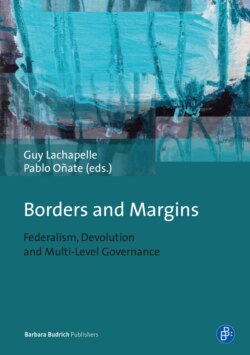Читать книгу Borders and Margins - Группа авторов - Страница 22
На сайте Литреса книга снята с продажи.
The strengths and weaknesses of MLG
ОглавлениеSimona Piattoni, in both her initial brief (2009) historical and conceptual overview of multilevel governance, and in her subsequent (2010) full-length volume on the conceptual, empirical and normative challenges posed by the theory of multilevel governance, defines MLG in broad and abstract terms as a dynamic three-dimensional concept involving 1) the relationship between the centre and periphery, 2) the relationship between state and society, and 3) the relationship between the domestic and the international. Each of these dimensions involves changes that occur at three analytical levels: 1) political mobilisation 2) policy-making and 3) policy restructuring. In this way, she claims to be able to generate a three-dimensional space within which to gauge MLG’s empirical scope and desirability in normative terms (Piattoni 2009:1).
But there are several major criticisms that one can level at the MLG concept, as Piattoni, among others, also notes. First, empirically it is unclear which phenomena MLG encompasses, and whether it can be significantly distinguished from “governance” in general or other similarly broad concepts. Secondly, its epistemological and ontological meaning is unclear, and it is not evident where it stands on the ladder of abstraction (Piattoni 2009: 1, citing Sartori 1984). Thirdly, normatively, it is uncertain whether political decisions made through MLG are more legitimate or better than decisions made through other processes. (for example, whether MLG ensures wider and fuller participation in decision-making). Fourthly, MLG includes a wide variety of actors within its political structures, including supranational bureaucrats in Brussels, major national governmental elites, and regional and local subnational authorities who have conflicting public philosophies and ideologies. This leaves the question open as to whether such a broad basis of political representation of its governing elites is not more likely to aggravate conflicts within the EU. Fifthly, and most importantly, MLG rests ultimately on the notion of a “network configuration”, rather than a “hierarchy”, an idea which lacks empirical precision, and is largely metaphorical in meaning. Its analytical utility has therefore been limited and open to question thus far (For example, see Piattoni 2009: 4).
But there are also several positive attributes and strengths in the multilevel governance approach, particularly in the current European context, that deserve recognition. For example, Gary Marks, in a seminal article in 1992, first questioned the sharply dichotomous view of European integration presented by neo-functionalists and intergovernmentalists. He particularly criticised their lack of attention to ‘flesh-and-blood’ actors” in their theories. He thereby [39] “asserted the autonomous explanatory force of a third paradigm, that of MLG” (Piattoni 2009: 2). Secondly, “MLG challenged the contention that non-state interests could only influence EU policy-making by operating through state representatives, and that they could not successfully challenge the ‘gate-keeping’ capacity of the central state” (Piattoni 2009:3). This insight was initially confined to cohesion policy, but later extended to environmental policy, agricultural policy and other important sectors of European policy. Thirdly, it is clear that the MLG concept is most appropriately applied to how the EU has actually operated since the signing of the Maastricht Treaty in 1991, and it has contributed to what may accurately be described as a new type of polity which is in fact sui generis. Fourthly, we also acknowledge the utility of the subsequent (2003) theoretical contribution of Marks and Hooghe to the initial concept of MLG in their distinction between Types I and II MLG. Type I MLG applies to at least three and up to five different levels of governance: international, supranational regional, national, subnational regional, and local. It therefore constitutes a modification and extension of the usual definition of federal systems as containing two levels of government, national and regional, with different jurisdictions and memberships. Type II MLG is also an ideal type that describes the political decision-making role of units and groups that are not part of the public sector, including private interest groups like business, labour and agriculture and non-profit voluntary or third sector groups such as charitable organisations and social assistance groups. According to Piattoni, “Type II governance normally coexists with Type I governance in the same overarching polity, and is generally embedded in Type I governance” (Piattoni 2009, citing Marks and Hooghe 2003: 238). These two types of overlapping governance structures coexist in a dynamic relationship that has been described as a “negotiated arrangement” in a new institutional order. It is considered to provide “technically superior solutions to complex collective problems [by] staying at a sufficiently small scale not to impose sacrifices on individual preferences” (Piattoni 2009. MLG, then, is a valuable “multilevel concept” that is capable of “moving across and connecting different analytical planes”. It can also encompass much of the current literature on regionalism, which postulates an apparent causal correlation between increasing political devolution and growing civil society involvement in governance. (Piattoni 2009: 7).
In short, MLG is a concept that has both strengths and weaknesses, but is still very much in the process of theoretical framing and evolution. “It captures a significant number of policy processes, forms of political mobilisation, and trends towards polity restructuring to warrant its continued use in the future” (Piattoni 2010:13).
